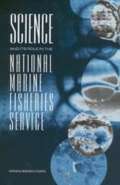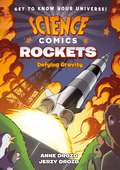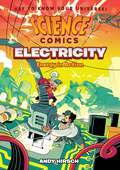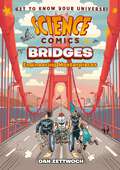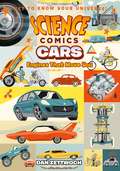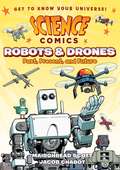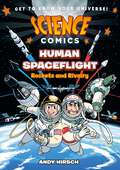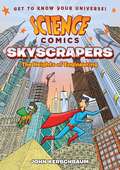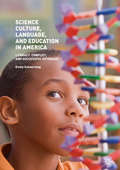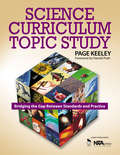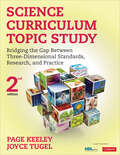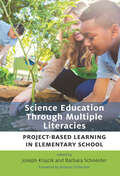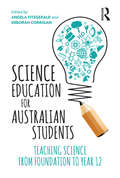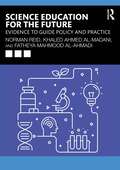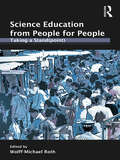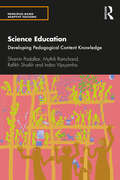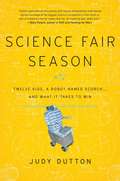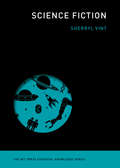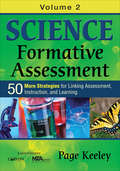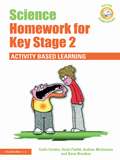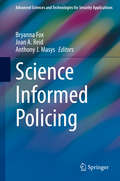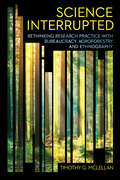- Table View
- List View
Science And Its Role In The National Marine Fisheries Service
by Ocean Studies BoardA report on Science And Its Role In The National Marine Fisheries Service
Science Comics: Defying Gravity (Science Comics)
by Anne Drozd Jerzy DrozdBlast off! Discover the history of rockets and their impact on the future with Anne and Jerzy Drozd in this volume of Science Comics, the action-packed nonfiction graphic novel series for middle-grade readers! Every volume of Science Comics offers a complete introduction to a particular topic—dinosaurs, coral reefs, the solar system, volcanoes, bats, flying machines, and many more. These gorgeously illustrated graphic novels offer wildly entertaining views of their subjects. Whether you're a fourth grader doing a natural science unit at school or a thirty-year-old with a secret passion for airplanes, these books are for you!This volume: In Rockets we explore the 2,000 years that rockets have been in existence. We dive into Newton's Laws of Motion—learning all about gravity, force, acceleration, and the history of rockets made in the past and rockets to be made in the future!
Science Comics: Energy in Action (Science Comics)
by Andy HirschGet a charge out of Electricity, a new edition to the Science Comics series!Giant monsters are on the warpath, and it’s Menlo the mech’s job to protect the city! But when this metal marvel is shut down by an unlucky lightning strike, a resourceful engineer and his high-energy niece will have to find a way to plug in and power up to save everyone from certain doom!From simple circuits to giant grids, fossil fuel power plants to wind farms, electricity keeps the world running. In Science Comics: Electricity, you’ll discover where electricity comes from, why lightning suddenly strikes, and how we’ve harnessed it all to turn the lights on in your room. Ready for action? Get energized with electricity!
Science Comics: Engineering Masterpieces (Science Comics)
by Dan ZettwochSuspend your disbelief with Science Comics: Bridges, a new volume of First Second's STEM graphic novel series!Follow Bea, Archie, Trudy, and Spencer (otherwise known as the BATS!) as they crisscross the globe using every type of bridge: beam, arch, truss, and suspension. From ancient low-slung rope bridges to modern hi-tech towers of steel, they’ll traverse ‘em all. Their journey will take them through history and connect them with new ideas and different cultures. Along the way they'll identify the dangerous forces trying to bring bridges crashing down, and how to defeat them…through engineering!
Science Comics: Engines That Move You (Science Comics)
by Dan ZettwochIn Dan Zettwoch's Science Comics: Cars, you'll learn where cars came from and how they work. When you pop the hood, what are you looking at? How does gasoline—or electric batteries, or even steam—make a car move? Rev up your motor and take look at the combustible history of the automobile and its explosive effects on our modern lives.Every volume of Science Comics offers a complete introduction to a particular topic—dinosaurs, the solar system, robots, and more. Whether you're a fourth grader doing a natural science unit at school or a thirty year old with a secret passion for airplanes, these books are for you!
Science Comics: Past, Present, and Future (Science Comics)
by Mairghread ScottIn factories! In the sky! In your cars and phones! In your own home! Robots are everywhere! And they have been for a lot longer than you might realize.From tea-serving robots in feudal Japan to modern rovers exploring Mars, robots have been humanity's partners, helpers, and protectors for centuries! Join one of the world's earliest robots, a mechanical bird named Pouli, as he explores where robots came from, how they work, and where they’re going in this informative and hilarious new book! Ever dreamt of building your own best friend? It might be easier than you think!Every volume of Science Comics offers a complete introduction to a particular topic—dinosaurs, coral reefs, the solar system, volcanoes, bats, flying machines, and more. These gorgeously illustrated graphic novels offer wildly entertaining views of their subjects. Whether you're a fourth grader doing a natural science unit at school or a thirty year old with a secret passion for airplanes, these books are for you!
Science Comics: Rockets and Rivalry (Science Comics)
by Andy HirschStrap in! Science Comics: Human Spaceflight is a new volume in First Second's STEM graphic novel series!Once humans figured out how to launch rockets into orbit, the Space Race between the US and USSR began! Who will be the first to fly outside of Earth’s atmosphere, walk on the moon, or build a working lab in orbit? Follow the story of how the race to the moon became international teamwork in orbit, and find out how to travel at 17,500 mph, take a shower with no water, and go to the bathroom when there’s no gravity. When it comes to human spaceflight, the sky is not the limit!
Science Comics: The Heights of Engineering (Science Comics)
by John KerschbaumLeave no brick unturned in John Kerschbaum's Science Comics: Skyscrapers, the latest volume in First Second’s action-packed nonfiction graphic novel series for middle-grade readers!Every volume of Science Comics offers a complete introduction to a particular topic—dinosaurs, the solar system, volcanoes, bats, robots, and more. These gorgeously illustrated graphic novels offer wildly entertaining views of their subjects. Whether you're a fourth grader doing a natural science unit at school or a thirty-year-old with a secret passion for airplanes, these books are for you!In this volume, join a pair of superheroes as they uncover the secrets of skyscrapers, from the great Egyptians pyramids to the world’s tallest building. Read along and learn how skyscrapers are a bold combination of applied physics, ingenuity, and a lot of hard work!
Science Culture, Language, and Education in America: Literacy, Conflict, And Successful Outreach
by Emily SchoerningCan the culture and language of science be an alienating force that discourages marginalized people from identifying with scientists and pursuing higher education in the sciences? More broadly, does an education system which unwittingly presents science as a distinct culture result in a population susceptible to doubt, confusion, and denial? This volume explores how this 'culture of science' is reflected and transmitted in the classroom, and how this can have wide-reaching and often negative implications for science education and science literacy. Well-intentioned efforts to bring hands-on scientific experiences into the classroom must also take into account how students perceive the culture of science. Areas of potential conflict include linguistic and cultural behaviors, misconceptions about science and the nature of science, and, in some cases, religious worldviews. Once recognized, these conflicts are resolvable, and valid methods exist to reduce alienation, broaden participation, and ensure that all students, whether or not they pursue STEM careers, leave school knowing that science is something that they can trust.
Science Curriculum Topic Study: Bridging the Gap Between Standards and Practice
by Page D. KeeleyThis indispensable staff development resource provides a systematic professional development strategy linking science standards and research to curriculum, instruction, and assessment.
Science Curriculum Topic Study: Bridging the Gap Between Three-Dimensional Standards, Research, and Practice
by Page D. Keeley Joyce TugelToday’s science standards reflect a new vision of teaching and learning. | How to make this vision happen Scientific literacy for all students requires a deep understanding of the three dimensions of science education: disciplinary content, scientific and engineering practices, and crosscutting concepts. If you actively engage students in using and applying these three dimensions within curricular topics, they will develop a scientifically-based and coherent view of the natural and designed world. The latest edition of this best-seller, newly mapped to the Framework for K-12 Science Education and the Next Generation Science Standards (NGSS), and updated with new standards and research-based resources, will help science educators make the shifts needed to reflect current practices in curriculum, instruction, and assessment. The methodical study process described in this book will help readers intertwine content, practices, and crosscutting concepts. The book includes: • An increased emphasis on STEM, including topics in science, technology, and engineering • 103 separate curriculum topic study guides, arranged in six categories • Connections to content knowledge, curricular and instructional implications, concepts and specific ideas, research on student learning, K-12 articulation, and assessment Teachers and those who support teachers will appreciate how Curriculum Topic Study helps them reliably analyze and interpret their standards and translate them into classroom practice, thus ensuring that students achieve a deeper understanding of the natural and designed world.
Science Curriculum Topic Study: Bridging the Gap Between Three-Dimensional Standards, Research, and Practice
by Page D. Keeley Joyce TugelToday’s science standards reflect a new vision of teaching and learning. | How to make this vision happen Scientific literacy for all students requires a deep understanding of the three dimensions of science education: disciplinary content, scientific and engineering practices, and crosscutting concepts. If you actively engage students in using and applying these three dimensions within curricular topics, they will develop a scientifically-based and coherent view of the natural and designed world. The latest edition of this best-seller, newly mapped to the Framework for K-12 Science Education and the Next Generation Science Standards (NGSS), and updated with new standards and research-based resources, will help science educators make the shifts needed to reflect current practices in curriculum, instruction, and assessment. The methodical study process described in this book will help readers intertwine content, practices, and crosscutting concepts. The book includes: • An increased emphasis on STEM, including topics in science, technology, and engineering • 103 separate curriculum topic study guides, arranged in six categories • Connections to content knowledge, curricular and instructional implications, concepts and specific ideas, research on student learning, K-12 articulation, and assessment Teachers and those who support teachers will appreciate how Curriculum Topic Study helps them reliably analyze and interpret their standards and translate them into classroom practice, thus ensuring that students achieve a deeper understanding of the natural and designed world.
Science Education Through Multiple Literacies: Project-Based Learning in Elementary School
by Joseph Krajcik and Barbara SchneiderScience Education Through Multiple Literacies explores how the use of project-based learning in elementary science education fosters a lifelong scientific mindset in students. The book provides educators with the teaching practices to help students develop an overall science literacy that aligns with Next Generation Science Standards.Editors Joseph Krajcik and Barbara Schneider and the book&’s contributors offer a comprehensive overview of the multifaceted approach to science learning. Multiple Literacies in Project-Based Learning (ML-PBL) interweaves scientific ideas and practices, language literacy, and mathematical thinking. ML-PBL supports the teaching of science by paralleling what scientists do: it engages students and their teachers in investigating real-world questions, constructing models, and using evidence to evaluate claims.The book presents compelling case studies of ML-PBL, how teachers use this approach, and how the ML-PBL transforms the classroom into an environment that builds and supports academic and student social-emotional learning. Representing both urban and suburban schools, the case studies include classroom observations, student and teacher interviews, and student artifacts to illustrate how to make science relevant in students&’ lives.Krajcik and Schneider note that application of ML-PBL requires intentional instructional practices and new ways of thinking about what it means to learn. Easing this challenge, the editors equip elementary science teachers with curricular resources including high-quality instructional materials, professional-learning exercises, and formative assessments.Science Education Through Multiple Literacies provides the necessary elements to transform science teaching and learning so that students learn the skills to navigate with confidence through our complex world.
Science Education for Australian Students: Teaching Science from Foundation to Year 12
by Angela FitzgeraldIn this ground-breaking book science education is explored as a learning continuum across all years of schooling from Foundation to Year 12. The expert authors, members of Monash University's Science Education Research Group, seek to build pedagogical and content expertise by providing both a level of support and challenge for all teachers based on current research and best practice. The text considers key issues including: what the learner brings to the science classroom; what primary and secondary teachers can learn from each other; the constructivist perspective and its value in learning science; context-based science education; the structure of the Australian curriculum and science education policy; teacher identity; the nature of scientific knowledge; principles of assessment and understanding the role of ICT in science teaching and learning. Featuring case studies and practical examples in each chapter, this book provides pre-service teachers with the understanding and tools to ensure their students are engaged and inspired in science education throughout their school years.
Science Education for the Future: Evidence to Guide Policy and Practice
by Norman Reid Khaled Ahmed Al-Madani Fatheya Mahmood Al-AhmadiThis book draws on the wealth of worldwide research into science education to establish a set of key principles for teaching secondary science. It considers the aims of science education and the themes and topics that should be included in the curriculum and how these can be effectively taught and assessed in a variety of contexts.Offering a framework for the training and professional development of science teachers, the chapters answer key questions such as: How can I help my students to make sense of difficult areas in my subject? What is meant by understanding, and how can I help my students achieve it? Is it possible to teach scientific thinking and how can I do it? What about learner attitudes when they are sometimes negative? What are the different ways to teach in the sciences that are effective? How can I make learning in the laboratory more efficient and effective? How can I employ assessment as a positive aid to learning?Including reflective questions, tasks and diagrams, this is essential reading for all student and practising secondary science teachers.
Science Education from People for People: Taking a Stand(point)
by Wolff-Michael RothContributing to the social justice agenda of redefining what science is and what it means in the everyday lives of people, this book introduces science educators to various dimensions of viewing science and scientific literacy from the standpoint of the learner, engaged with real everyday concerns within or outside school; develops a new form of scholarship based on the dialogic nature of science as process and product; and achieves these two objectives in a readable but scholarly way. Opposing the tendency to teach and do research as if science, science education, and scientific literacy could be imposed from the outside, the authors want science education to be for people rather than strictly about how knowledge gets into their heads. Taking up the challenges of this orientation, science educators can begin to make inroads into the currently widespread irrelevance of science in the everyday lives of people. Utmost attention has been given to making this book readable by the people from whose lives the topics of the chapters emerge, all the while retaining academic integrity and high-level scholarship. Wolff Michael Roth has been awarded the Distinguished Contributions Award by The National Association for Research in Science Teaching, for his contributions to research in this field. He has also been elected to be the Fellow of the American Association for Advancement of Science (AAAS) and Fellow of the American Educational Research Association.
Science Education: Developing Pedagogical Content Knowledge (Principles-based Adaptive Teaching)
by Shamin Padalkar Mythili Ramchand Rafikh Shaikh Indira VijaysimhaThe book presents key perspectives on teaching and learning science in India. It offers adaptive expertise to teachers and educators through a pedagogic content knowledge (PCK) approach. Using cases and episodes from Indian science classrooms to contextualise ideas and practices, the volume discusses the nature of science, and aspects of assessments and evaluations for both process skills and conceptual understanding of the subject. It examines the significance of science education at school level and focuses on meaningful learning and development of scientific and technological aptitude. The chapters deal with topics from physics, chemistry and biology at the middle- and secondary-school levels, and are designed to equip student-teachers with theoretical and practical knowledge abilities about science, science learning and the abilities to teach these topics along with teaching. The book draws extensively from research on science education and teacher education and shifts away from knowledge transmission to the active process of constructivist teaching-learning practices. The authors use illustrative examples to highlight flexible planning for inclusive classrooms. Based on studies on cognitive and developmental psychology, pedagogical content knowledge of science, socio-cultural approaches to learning science, and the history and philosophy of science, the book promotes an understanding of science characterized by empirical criteria, logical arguments and sceptical reviews. With its accessible style, examples, exercises and additional references, it will be useful for students and teachers of science, science educators, BEd and MEd programmes for education, secondary and higher secondary school teachers, curriculum designers and developers of science. It will interest research institutes, non-governmental organisations, professionals and public and private sector bodies involved in science outreach, science education and teaching and learning practices.
Science Fair Season: Twelve Kids, a Robot Named Scorch . . . and What It Takes to Win
by Judy DuttonThis is the engaging true story of kids competing in the high-stakes, high-drama world of international science fairs. Every year the Intel International Science & Engineering Fair brings together 1,500 high schoolers from more than 50 countries to compete for over $4 million dollars in prizes and scholarships. These amazing kids are doing everything from creating bionic prosthetics to conducting groundbreaking stem cell research, from training drug-sniffing cockroaches to building a nuclear reactor. In Science Fair Season, Judy Dutton follows twelve teens looking for science fair greatness and tells the gripping stories of their road to the big competition. Some will win, some will lose, but all of their lives are changed forever.The Intel International Science & Engineering Fair is the most prominent science fair in the country, and it takes a special blend of drive, heart, and smarts to win there. Dutton goes inside the inner sanctum of science fair competitions and reveals the awe-inspiring projects and the competitors there. Each of the kids--ranging from a young Erin Brokovich who made the FBI watch list for taking on a big corporation, to a quietly driven boy who lives in a run-down trailer on a Navajo reservation, to a wealthy Connecticut girl who dreams of being an actress and finds her calling studying bees, to a troubled teenager in a juvenile detention facility, to the next Bill Gates--take readers on an unforgettable journey. Along the way, Science Fair Season gives readers a glimpse of America's brightest young minds and shows how our country is still a place for inventors and dreamers--the "geeks" our future depends upon.ce & Engineering Fair brings together 1,500 high schoolers from more than 50 countries to compete for over $4 million dollars in prizes and scholarships. These amazing kids are doing everything from creating bionic prosthetics to conducting groundbreaking stem cell research, from training drug-sniffing cockroaches to building a nuclear reactor. In Science Fair Season, Judy Dutton follows twelve teens looking for science fair greatness and tells the gripping stories of their road to the big competition. Some will win, some will lose, but all of their lives are changed forever.The Intel International Science & Engineering Fair is the most prominent science fair in the country, and it takes a special blend of drive, heart, and smarts to win there. Dutton goes inside the inner sanctum of science fair competitions and reveals the awe-inspiring projects and the competitors there. Each of the kids--ranging from a young Erin Brokovich who made the FBI watch list for taking on a big corporation, to a quietly driven boy who lives in a run-down trailer on a Navajo reservation, to a wealthy Connecticut girl who dreams of being an actress and finds her calling studying bees, to a troubled teenager in a juvenile detention facility, to the next Bill Gates--take readers on an unforgettable journey. Along the way, Science Fair Season gives readers a glimpse of America's brightest young minds and shows how our country is still a place for inventors and dreamers--the "geeks" our future depends upon.
Science Fiction: Science Fiction And The Question Of The Animal (The MIT Press Essential Knowledge series #39)
by Sherryl VintHow science fiction has been a tool for understanding and living through rapid technological change.The world today seems to be slipping into a science fiction future. We have phones that speak to us, cars that drive themselves, and connected devices that communicate with each other in languages we don't understand. Depending the news of the day, we inhabit either a technological utopia or Brave New World nightmare. This volume in the MIT Press Essential Knowledge surveys the uses of science fiction. It focuses on what is at the core of all definitions of science fiction: a vision of the world made otherwise and what possibilities might flow from such otherness.
Science Formative Assessment, Volume 1: 75 Practical Strategies for Linking Assessment, Instruction, and Learning
by Page D. KeeleyFormative assessment informs the design of learning opportunities that take students from their existing ideas of science to the scientific ideas and practices that support conceptual understanding. Science Formative Assessment shows K-12 educators how to weave formative assessment into daily instruction. Discover 75 assessment techniques linked to the Next Generation Science Standards and give classroom practices a boost with: Descriptions of how each technique promotes learning Charts linking core concepts at each grade level to scientific practices Implementation guidance, such as required materials and student grouping Modifications for different learning styles Ideas for adapting techniques to other content areas
Science Formative Assessment, Volume 1: 75 Practical Strategies for Linking Assessment, Instruction, and Learning
by Page D. KeeleyFormative assessment informs the design of learning opportunities that take students from their existing ideas of science to the scientific ideas and practices that support conceptual understanding. Science Formative Assessment shows K-12 educators how to weave formative assessment into daily instruction. Discover 75 assessment techniques linked to the Next Generation Science Standards and give classroom practices a boost with: Descriptions of how each technique promotes learning Charts linking core concepts at each grade level to scientific practices Implementation guidance, such as required materials and student grouping Modifications for different learning styles Ideas for adapting techniques to other content areas
Science Formative Assessment, Volume 2: 50 More Strategies for Linking Assessment, Instruction, and Learning
by Page D. KeeleyDeepen scientific understanding with formative assessment! Only by really knowing what your students are thinking can you design learning opportunities that deepen content mastery and meet their individual needs. In this highly engaging resource, internationally respected expert Page Keeley shares 50 new techniques to pinpoint student understanding before, during, and after instruction. In addition to promoting best practices in the classroom, the techniques shared here support learning and link instruction to the Next Generation Science Standards. These flexible assessments can be used with any science curriculum, along with: Practical strategies for use throughout the instruction cycle Considerations for implementation and suggestions for modification An explanation of how each technique promotes learning
Science Homework for Key Stage 2: Activity-based Learning (Active Homework)
by Colin Forster Vicki Parfitt Andrea McGowanScience Homework for Key Stage 2 is a unique resource for busy teachers - a selection of ‘pencil-free’, hands-on activities, aligned with the National Curriculum Programmes of Study and with clear links to the topics set out in the QCA scheme of work for KS2 science, that teachers can use as extension activities or give to pupils as homework to do with members of their family or friends. Each of the activities encourages the pupils to learn through discussion and through practical activities utilising everyday resources. Each activity is quick and easy for pupils and teachers to manage, and includes: a learning aim, full, clear instructions and discussion points tasks to foster collaboration and partnership between pupils, parents and teachers photocopiable resources. A refreshing approach for teachers and pupils, these activities will foster enthusiasm for learning and inspire pupils' interest in science.
Science Informed Policing (Advanced Sciences and Technologies for Security Applications)
by Anthony J. Masys Bryanna Fox Joan A. ReidThe current policing landscape has seen the rise in serious and organized crime across the globe. Criminals are innovating in real-time leveraging cyber, social media, enhanced surveillance to support their activities. In so doing, the criminal landscape has become transnational whereby collaborative networks have flourished thereby creating greater complexity and novel threats for the international policing community. As new threats to local, regional, national and global security are emerging, leveraging science and technology innovations has become more important. Advances in big data analytics, cyber forensics, surveillance, modeling and simulation has led to a more data driven, hypothesis generated and model informed approach. Novel science and technology innovations are presented in this edited book to provide insights and pathways that challenges the emerging and complex criminal threat landscape by supporting policing operations.
Science Interrupted: Rethinking Research Practice with Bureaucracy, Agroforestry, and Ethnography (Expertise: Cultures and Technologies of Knowledge)
by Timothy G. McLellanScience Interrupted examines how scientists in China pursue environmental sustainability within the constraints of domestic and international bureaucracies. Timothy G. McLellan offers a theoretical framework for analyzing the formal procedural work of Chinese bureaucracy—work that is overlooked when China scholars restrict their gaze to the informal and interpersonal channels through which bureaucracy is often navigated. Homing in on an agroforestry research organization in southwest China, the author takes the experiences of the organization's staff in navigating diverse international funding regimes and authoritarian state institutions as entry points for understanding the pervasiveness of bureaucracy in contemporary science. He asks: What if we take the tools, sensibilities, and practices of bureaucracies seriously not only as objects of critique but as resources for re-thinking scientific practice? Extending a mode of anthropological research in which ethnography serves as source of theory as well as source of data, Science Interrupted thinks with, and not only against, bureaucracy. McLellan shows that ethnographic engagement with bureaucracy enables us to imagine more democratic and more collaborative modes of scientific practice.
